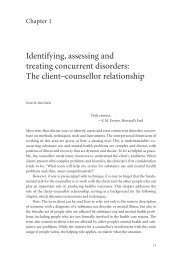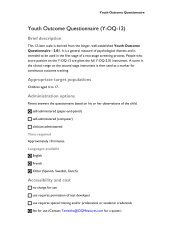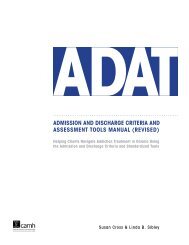Clinical Supervision Handbook - CAMH Knowledge Exchange ...
Clinical Supervision Handbook - CAMH Knowledge Exchange ...
Clinical Supervision Handbook - CAMH Knowledge Exchange ...
Create successful ePaper yourself
Turn your PDF publications into a flip-book with our unique Google optimized e-Paper software.
cannabis use—which Janet felt was quite positive—as well as the<br />
importance of the client’s efforts and strengths outside of the<br />
therapeutic relationship.<br />
The clinical supervisor then explored feelings around the client<br />
“going through the motions” and discussed if this interfered with<br />
Janet’s lack of feelings of success about this client. The clinical<br />
supervisor then asked about whether cas would object to<br />
occasional marijuana use, given that her doctor had prescribed<br />
her marijuana, and concluded this would likely not be a great<br />
concern to cas.<br />
Finally the clinical supervisor gave her some feedback about her<br />
approach with the client. She told Janet that she could use the last<br />
two sessions to tell the client what she really thought about the<br />
marijuana use, or she could work toward cultivating a<br />
relationship with the client so if she ever wanted to address the<br />
marijuana use or her feelings around using crack cocaine, this<br />
would be a safe place for the client to return regardless of whether<br />
she was still involved with cas.<br />
Janet was able to see that her approach to the client had been<br />
focused more on substance use (very common in a substance<br />
use service) and less on maintaining a relationship with the client<br />
to foster further growth and development if the client wished to<br />
seek out further treatment.<br />
LEARNING STYLES<br />
Beginning <strong>Clinical</strong> <strong>Supervision</strong><br />
A learning style is “a predominant and preferred approach which characterizes an<br />
individual’s attitude and behaviour in a learning context” (Bogo & Vayda, 1998,<br />
p. 100). Clinicians may not have considered how their learning styles or needs might<br />
differ from those of their colleagues or the clinical supervisor. Learning styles can<br />
vary on a variety of dimensions.<br />
33

















